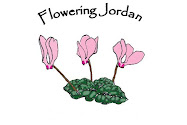While on our afternoon hike, we met one of the reserve's scouts; he continued on with us as far as Look-Out Point. Dear Husband asked him for tips on ibex-spotting and he advised us to visit the bird-watch near camp at about seven in the morning.
Late that evening we agreed to make our way down to the bird watch in the morning, quietly and with no talking. I arrived first, at about 6:30am, followed by Tayta and then my mom and dad. Dear Husband went solo to another rock.
Through the slit in the bird-watch wall, we focused our eyes on the small pond of water about 15 meters in front of us. Waiting. Waiting. First to visit were the Bulbuls.
They never came all the way to the pond for their morning drink. Maybe they heard the click of my camera shutter.
Just a short while later, Tayta whispered and pointed, "Look! Ibex!" Perhaps they were coming for a drink and had we been quieter they might have come closer. We couldn't resist taking pictures, though. These look like juvenile ibex. Reading about them post-sighting I learned that female and juvenile ibex travel in groups but the adult males live in separate herds, except for during the mating season.


Through the slit in the bird-watch wall, we focused our eyes on the small pond of water about 15 meters in front of us. Waiting. Waiting. First to visit were the Bulbuls.
White-Spectacled Bulbul
Pycnonotus xanthopygos
FAMILY PYCNONOTIDAE
Next to arrive were the Greenfinches.
Greenfinch
Carduelis chloris
FAMILY FRINGILLIDAE
The Chukers make a lot of noise, so we could hear a group of them approaching on foot.
Chuker
Alectoris chuckar
FAMILY PHASIANDAE
We had been in the bird-watch for about forty minutes, and our hopes of spotting an ibex were beginning to wane. We are not seasoned or patient wildlife spotters--which is probably why Dear Husband set of on his own.
Tayta spotted this spider crawling along the bird-watch all in front of us. (His leg span was about 3-4 inches). It turned out to be a don't-bother-him-and-he-won't-bother-you situation, but we shifted around in the watch as the spider periodically scurried back and forth in front of us.
Just a short while later, Tayta whispered and pointed, "Look! Ibex!" Perhaps they were coming for a drink and had we been quieter they might have come closer. We couldn't resist taking pictures, though. These look like juvenile ibex. Reading about them post-sighting I learned that female and juvenile ibex travel in groups but the adult males live in separate herds, except for during the mating season.
Nubian Ibex
Capra ibex nubiana
FAMILY BOVIDAE
Dear Husband was rewarded with the sighting of a single male ibex with very large curled horns and a goatee. None of had previously seen an ibex so near to us in all our trips to Wadi Dana. I also read that the ibex tend to stay down in the valley in the spring (for grass) and winter (it's warmer in the valley) so my theory is that they were still up high, near the camp, since the warm summer weather was just beginning to fade, and were therefore easier to spot. Maybe. If so, it adds incentive to return to Wadi Dana twice a year: spring and fall.
A couple more bird sightings and subsequent identifications, helped by the knowledgeable birders in the Jordan Birdwatching Facebook group.

Tristam Grackle

Rock Sparrow
And, not exactly wildlife, but one more picture of some non-indigenous creatures enjoying God's creation at Wadi Dana:



















































